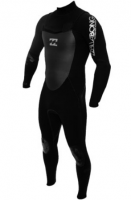








A wetsuit is a garment, usually made of foamed neoprene, which is worn by surfers, divers, windsurfers, canoeists, and others engaged in water sports, providing thermal insulation, abrasion resistance and buoyancy. The insulation properties depend on bubbles of gas enclosed within the material, which reduce its ability to conduct heat. The bubbles also give the wetsuit a low density, providing buoyancy in water.
History
In 1952, UC Berkeley and subsequent UC San Diego SIO physicist Hugh Bradner, who is considered to be the original inventor and "father of the modern wetsuit,"had the insight that a thin layer of trapped water could be tolerated between the suit fabric and the skin, so long as insulation was present in the fabric in the form of trapped bubbles. In this case, the water would quickly reach skin temperature and the air in the fabric would continue to act as the thermal insulation to keep it that way. In the popular mind, the layer of water between skin and suit has been credited with providing the insulation. But as his letter notes, Dr. Bradner clearly understood the suit did not need to be wet because it isn't the water that provides the insulation but rather the gas in the suit fabric.He initially sent his ideas to Lauriston C. "Larry" Marshall. Marshall was involved in a U.S. Navy/National Research Council Panel on Underwater Swimmers.However, it was Willard Bascom, an engineer at the Scripps Institution of Oceanography in La Jolla, California, who suggested neoprene as a feasible material to Bradner.
However, Bradner and Bascom were not overly interested in profiting from their design and were unable to successfully market a version to the public. They attempted to patent their neoprene wetsuit design, but their application was rejected because the design was viewed as too similar to a flight suit. The United States Navy also turned down Bradner's and Bascom's offer to supply its swimmers and frogmen with the new wetsuits due to concerns that the gas in the neoprene component of the suits might make it easier for naval divers to be detected by underwater sonar.The first written documentation of Bradner's invention was in a letter to Marshall, dated June 21, 1951.
Jack O'Neill started using closed-cell neoprene foam which was shown to him by his bodysurfing friend, Harry Hind, who knew of it as an insulating material in his laboratory work.After experimenting with the material and finding it superior to other insulating foams, O'Neill founded the successful wetsuit manufacturing company called O'Neill in a garage in 1952, later relocating to Santa Cruz, California in 1959 with the motto "It's Always Summer on the Inside".Bob and Bill Meistrell, from Manhattan Beach, California, also started experimenting with neoprene around 1953. They started a company which would later be named Body Glove.
Neoprene was not the only material used in early wetsuits, particularly in Europe. The French-made Pêche-Sport Suit and the UK-made Siebe Gorman Swimsuit were both made out of sponge rubber. The Heinke Dolphin Suit of the same period, also made in England, came in a green male and a white female version, both manufactured from natural rubber lined with stockinet.
Design
Originally, wetsuits were made only with raw sheets of foam-rubber neoprene that did not have any backing material. This type of suit required extra caution while pulling it on because the raw foam-rubber by itself is both fragile and sticky against bare skin. Stretching and pulling excessively easily caused these suits to be torn in half. This was somewhat remedied by thoroughly powdering the suit and the diver's body with talc to help the rubber slide on more easily.
Backing materials first arrived in the form of nylon sheeting applied to one side of the neoprene. This allowed a swimmer to pull on the suit relatively easily since the tough nylon took most of the strain of pulling on the suit, but the suit still had the black sheet rubber exposed on the outside and the nylon was very stiff and rigid, limiting flexibility. A small strip reversed with the rubber against the skin could help provide a sealing surface to keep water out around the neck, wrists, and ankles.
In the early 1960s, the British Dunlop Sports Company brought out its yellow Aquafort neoprene wetsuit, whose high visibility was designed to improve diver safety. However, the line was discontinued after a short while and wetsuits reverted to their black uniformity. The colorful wetsuits seen today first arrived in the 1970s when double-backed neoprene was developed. Now the foam-rubber was sandwiched between two protective fabric outer layers, greatly increasing the tear-resistance of the material. An external layer also meant that decorative colors, logos, and patterns could be made with panels and strips sewn into various shapes. This growth from bare flat black rubber to full color took off in the 1980s with brilliant fluorescent colors common on many suits.